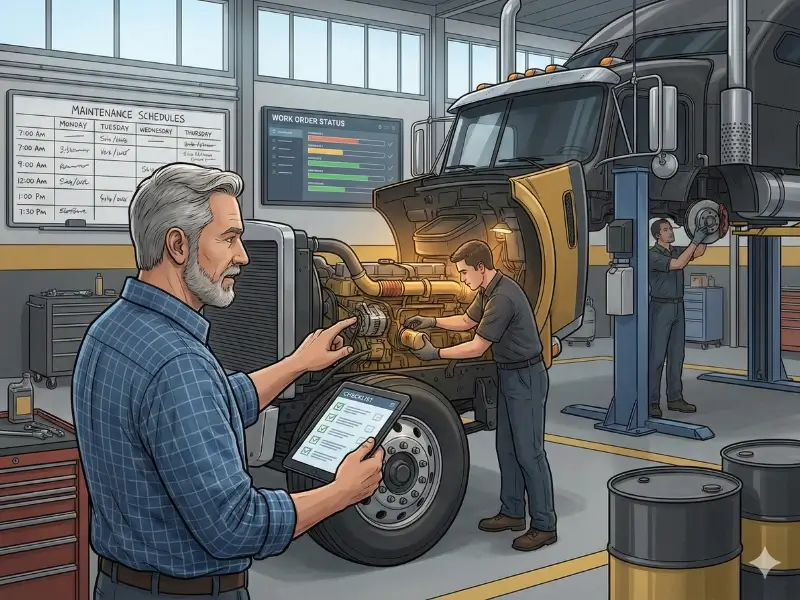Key Takeaways
Capitalizing OEM schedules can be extremely beneficial - find out here why it is important, what the limitations are, and how to use it to maximize your fleet's performance. Staying up to date with appropriate OEM schedules helps maintain and keep your vehicles running smoothly.
OEM (Original Equipment Manufacturer) schedules can be a useful reference for fleet managers when planning vehicle maintenance. OEM schedules typically outline the recommended intervals for various maintenance tasks, such as oil changes, tire rotations, and brake inspections.
Having a reliable truck maintenance program is essential to keep your fleet running smoothly. It can be one of the biggest expenses you'll face.
A OEM maintenance schedule is the factory-recommended list of service tasks and service intervals that help a vehicle stay reliable and safe. It acts as a baseline vehicle maintenance schedule that fleets can customize based on usage, conditions, and performance insights.

The Importance of Adhering to an OEM Schedule
Following an OEM maintenance pattern is essential to safeguard the resale value of vehicles across a fleet. Fleet management software can track service history. You can later share it with potential buyers. This tracking reduces the chances of having more repair requirements. Thereby, helping to improve OEM repair management and optimize vehicle lifespan.
Following OEM guidelines is also important to guarantee vehicle warranty coverage. As long as you follow their specific vehicle maintenance recommendations, OEMs will honor warranty coverage. This may include servicing only at certain locations or specific mileage milestones for maintenance.
Maintaining a fleet of vehicles is an important and costly part of fleet management. To help reduce service costs, it is essential to capitalize OEM schedules for vehicle maintenance. Following the OEM recommendations is important to make the most of the protection of a warranty.
For most fleets, the OEM guidelines form the foundation of a broader vehicle maintenance schedule, ensuring that essential tasks aren’t missed even as vehicles age or operate in demanding conditions.
By following an OEM maintenance schedule, fleet managers can rest assured that their vehicles are receiving the necessary care and attention they need.
Consistently following OEM recommendations also helps fleets reduce service errors, a common issue when intervals are guessed or stretched too far. Clear, documented maintenance timing supports warranty compliance and ensures your team knows exactly how to ensure maintenance compliance with manufacturer recommendations across different vehicle types.
Critical Components of OEM Maintenance Schedules
OEM (Original Equipment Manufacturer) maintenance schedules are designed to keep vehicles running smoothly and efficiently. These schedules outline specific tasks that should be performed at various mileage or OEM intervals based on time to ensure optimal performance, safety, and vehicle longevity.
Here's an in-depth look at the critical components of these schedules:
Common Maintenance Tasks
Oil and Filter Changes:
Regular oil changes are essential to keep the engine lubricated and running efficiently. Dirty oil can cause engine wear and decrease fuel efficiency. It is typically recommended after driving every 3,000 to 7,500 miles, depending on the vehicle's health.
Tire Rotations and Alignments:
Rotating tires helps ensure even tire wear, which can extend the life of the tires and improve vehicle handling. Alignments ensure the wheels are correctly aligned, reducing tire wear and improving fuel efficiency. They usually recommend every 6,000 to 8,000 miles.
Brake Inspections and Replacements:
Regular preventive maintenance inspections of brake pads, rotors, and fluid levels are crucial for vehicle safety. Brake pad replacements are typically needed every 20,000 to 50,000 miles, depending on driving habits and conditions.
These tasks are part of what many manufacturers outline as their manufacturer-recommended service intervals, which help owners maintain performance standards set by the original factory team.
Interval-Based Maintenance
Maintenance schedules are divided into specific service intervals, such as:
- 5,000 Miles: Basic tasks like oil changes, tire rotations, and inspections of brakes and fluids.
- 10,000 Miles: More comprehensive inspections, including checking the battery, cooling, and exhaust systems.
- 30,000 Miles: Replacement of air filters, fuel filters, and sometimes transmission fluid.
- 60,000 Miles and Beyond: Major services like timing belt replacement, spark plug replacement, and more in-depth inspections.
For example, Ford’s SUVs often follow 5K–10K–20K mile service patterns, while GM models recommend checking fluids and filters around similar intervals. Even luxury sedans like the Lincoln MKZ follow OEM-defined maintenance cycles that emphasize brake checks and fluid replacements.
Seasonal and Annual Maintenance
Seasonal Tasks:
Prepare the vehicle for winter or summer by checking the heating and cooling systems, changing windshield wipers, and ensuring the tires suit the season.
Annual Checks:
Comprehensive inspections of the entire vehicle, including the battery, lights, brakes, and emissions system. These checks help catch issues early and maintain vehicle performance.
Customization and Flexibility
These maintenance schedules often provide OEM guidelines for different driving conditions:
- Severe Driving Conditions: These include frequent short trips, towing, extreme temperatures, and driving in dusty conditions. These require more frequent maintenance.
- Normal Driving Conditions: Standard intervals apply for moderate driving habits and environments.
In practice, most fleets blend OEM maintenance schedules with preventive maintenance strategies, adjusting intervals based on telematics data, driving behavior, and environmental stress.
Visual Aids and Digital Tools
Modern OEM maintenance schedules may include:
- Visual Aids: Infographics and diagrams that help explain DIY vehicle maintenance based on OEM guidelines.
- Digital Tools: Mobile fleet management apps and software where vehicle owners can track maintenance, receive reminders, and book service appointments.
Download Our Free Fleet Maintenance Resources Now!
How to Follow the OEM Maintenance Schedule?
There are a few ways that fleet managers can capitalize on OEM schedules to improve their vehicle maintenance:
1. Use OEM schedules as a starting point
Fleet managers can use OEM schedules as a guideline for when to schedule maintenance tasks. However, it's important to keep in mind that these schedules may not be appropriate for all vehicles or operating conditions. So it may be necessary to adjust the intervals based on factors. These may be vehicle type, usage patterns, and local weather conditions.
2. Monitor vehicle performance
Fleet managers can use telematics data and other performance metrics to monitor how well their vehicles are performing. This also helps them to identify any issues that may require maintenance. This can help to catch problems early and prevent costly breakdowns.
3. Customize maintenance plans
Fleet managers can work with their maintenance team to customize a maintenance plan. The plan considers their vehicles' specific needs and operating conditions. This may involve adapting OEM schedules or developing entirely new preventive maintenance plans.
4. Communicate with OEMs
Fleet managers can reach out to OEMs to discuss their specific maintenance needs. They can also ask for guidance on how to optimize their maintenance schedule.
OEMs may be able to provide additional resources or recommendations based on their expertise and experience.
OEM schedules can be a useful tool for fleet managers when it comes to maintaining their vehicles. These schedules outline the recommended intervals for various maintenance tasks, such as oil changes, tire rotations, and brake inspections. Thereby, providing a starting point for fleet managers to plan their maintenance activities.
However, it's important to recognize that OEM schedules may not be appropriate for all vehicles or operating conditions. For example, a fleet manager operates a fleet of heavy-duty trucks in a hot, dusty environment. This truck may need to adjust the maintenance intervals recommended by the OEM to account for the harsher operating conditions.
While OEM guidelines are a strong starting point, fleet managers usually incorporate these intervals into a more detailed fleet maintenance schedule that accounts for real-world usage and downtime planning.
Limitations of OEM Schedule
OEM schedules are a great way to ensure that vehicles are properly maintained. Their scope is limited. OEMs typically provide general guidelines for maintenance. Although they may not take into account specific conditions or usage of the vehicle.
For example, if a fleet operates in extreme weather conditions or is used for off-road applications. The fleet may require additional maintenance beyond what is recommended by the OEM.
The biggest problem with regular maintenance is that it does not consider a truck's conditions. It only relies on the age and runtime of a truck. This is not always the main reason for breakages. You must also take into consideration a number of other elements. For Example, environmental factors, heat, pressure, vibrations, etc. These issues can not be anticipated and do not occur at fixed time gaps.
Finding the ideal amount of maintenance between over-maintenance and under-maintenance is important for time-based vehicle upkeep plans. Delaying the scheduled maintenance may cause problems. Assets may fail due to a lack of care and attention.
OEM service technicians are likely to commit errors as frequent maintenance can lead to incorrect reassembly or improper lubrication. Unnecessary maintenance should be avoided as it is wasteful in regard to both OEM parts and manpower.
Benefits of using Simply Fleet for OEM Service Schedule
Simply Fleet provides an efficient way to manage OEM service schedules across a fleet of vehicles. Ensuring that vehicles are serviced according to the OEM guidelines. This is important for preserving resale value and avoiding unplanned vehicle downtime. Additionally, adhering to these guidelines can help guarantee warranty coverage from OEMs.
Furthermore, having fleet management software in place allows for easy tracking of service history. We can share this with potential buyers when it comes time to resell vehicles. Ultimately, Simply Fleet provides a comprehensive solution for managing vehicle maintenance schedules across an entire fleet of vehicles.
Simply Fleet is designed to help fleet managers reduce downtime and vehicle maintenance repair costs by ensuring that vehicles follow an accurate service schedule. With just a few clicks, users can easily edit time and mile intervals, due-soon thresholds, and add/edit/remove service reminders across their entire fleet. This helps them remain compliant and reduce service costs while simplifying the process of managing preventative maintenance.
Related Posts
- How to Maintain a Vehicle Maintenance Log?
- How to Choose the Best Fleet Vehicle Maintenance App in 2024: The Ultimate Guide
Conclusion
Overall, capitalizing on OEM schedules can be an effective way for fleet managers to ensure that their vehicles are well-maintained and operating at peak performance. OEM schedules can be used as a starting point by fleet managers. They can adapt to them to meet the specific needs of their fleet. Fleet managers can optimize their vehicle maintenance activities and keep their vehicles running smoothly.
When combined with a structured vehicle maintenance schedule, OEM guidance helps fleets maintain consistent standards without over- or under-servicing their assets.



.png)








.png)


.png)






.webp)


